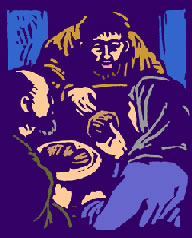
2nd Sunday of Easter Year A
Our faith is grounded in the witness of the apostles. This witness had its origins in an overwhelming experience: a meeting, against all their expectations, with the final achievement in God’s work of creation, the greatness of the Risen Lord. The gospel accounts echo this experience. Meditating on them gives us a greater appreciation of this foundation of our faith – the ‘teaching of the apostles’ that has gathered the Church in faith, since its beginnings in Jerusalem.
John’s gospel, as we know, is the product of profound reflection on this gospel tradition. The more we come to know it, the more we recognise how much is implied in its apparently simple narrative (even, it seems, reference to the fact that the celebration of the Lord’s Resurrection on ‘the first day of the week’ had its origin in the generation of the apostles).
It has often been pointed out that our understanding of the Easter Mystery has been shaped by Luke’s schema of three distinct events: Resurrection, Ascension (40 days later), Pentecost (10 days later). In John’s gospel, the Easter Mystery, is already experienced in all its aspects on Easter Day itself. Meeting Mary of Magdala, Jesus speaks of his imminent ‘ascent’ to the Father; and when he comes to the apostles place of refuge, on the evening of that same day, the Saviour who had ‘emptied himself’ becoming as we all are, shows himself already one with the Father in divine greatness and authority, as he bestows ‘the Holy Spirit’ and commissions the apostles to undertake their great mission – ‘As the Father has sent me, so am I sending you’. John’s narrative tells of the apostles’ experience as a passing from apprehension and uncertainty – ‘the doors were closed for fear of the Jews’ – to the reassurance and joy brought by faith in the Risen Lord. Three times in this narrative he repeats his greeting, ‘Peace be with you’. Given the fact that this is their first encounter with the one they had abandoned to his fate, even denied, these words three times repeated are far more than a conventional greeting. They echo down through the ages as words of divine forgiveness and reconciliation for a world whose burdens he has taken upon himself in the terrible drama of the cross. The gospels all speak of the hesitations experienced by the group as they came to terms with their experience, and passed from fear and uncertainty to the joy of believing. In John’s narrative, this is all dramatised in the story of Thomas, the outspoken enthusiast, who tells Jesus, ‘We do not know where you are going, how we can know the way?’ and urges the group, ‘Let us go up and die with him!’ As in other gospel accounts, Jesus makes it clear that what they have encountered is not a ghostly apparition, but his Incarnate Self: ‘Put your finger here, your hand in my side. Doubt no longer but believe’. And so, as John’s narrative comes to its climax in Thomas’ confession – ‘My Lord and my God’ – we hear echoes of the gospel’s opening, ‘The Word became flesh’ (1:18), and an echo of its meditation on the Eucharist, ‘The bread that I shall give is my flesh for the life of the world’ (6:51).
Even for the apostolic group, ‘seeing’ was not ‘believing’. The ‘seeing’ of their extraordinary and mysterious encounter was an invitation to accept the Saviour’s gift of faith. Each Easter brings the same invitation to us all: ‘Happy are those who have not seen and yet believe’. Peter has this same message: ‘You did not see him yet you love him, filled with a joy so glorious that it cannot be described’.
John Thornhill sm

